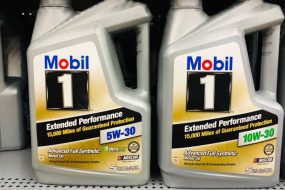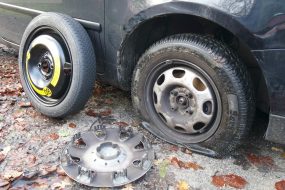
Coolant is undoubtedly the most crucial fluid under the hood of your automobile, and for a good reason. Without it, your engine wouldn’t last more than a few minutes before experiencing a catastrophic breakdown, possibly resulting in irreversible damage.
Regularly checking your coolant and adding more antifreeze is an excellent method to spot problems early. Therefore, does the car need to be running when adding coolant?
No, your car should not be running when adding coolant, rather, your car should be off. You must ensure that your car engine is off, and the engine is cool before opening the coolant cap to prevent the boiling coolant from burning your skin. Also, the car must be in Park or Neutral with the hand brake in use.
Does The Car Need to be Running When Adding Coolant?
Coolant circulates through your car’s engine, maintaining a constant temperature and removing excess heat. As a result, while it may appear that the car must be running to add coolant, this is not the case.
If you do it that way, it can lead to irreversible damage, and you can’t determine how much coolant is left when the engine is heating up.
You should turn off your engine and let it cool, put the vehicle in neutral or park, and engage the parking brake before adding the coolant.
What Happens When a Coolant is Added When the Car is Running?
There are several causes or damages done to your car when adding coolant to a running vehicle. These damages are:
1. Risk of Getting a Severe Burn
As the cover of the engine coolant reservoir already reminds you, you shouldn’t touch it when it’s still running for your health’s sake. Unscrewing the coolant cap would harm you as it is boiling and pressurized.
You are expected to wait for some minutes before opening the coolant cap. The engine should cool down before that is done to avoid having hot coolant/water all over your body. Imagine a hot coolant getting to your face.
2. It Could Lead to Car Engine Damage
As the cold liquid hits the hot engine, it might crack due to the sudden compression of the metal, which will eventually cause the engine block to crack; this doesn’t sound good.
Nobody wants to drive a car whose engine is in bad condition. In fact, you don’t want to hear that your car got spoilt because you tried to add coolant to your car while the engine is running and hot.
You can quickly open the hood of your car so the engine can quickly cool down before adding the coolant.
3. It Causes Coolant to Expand
Adding coolant to your car when the engine is running will cause the coolant to expand. When this happens it messes up the coolant level reading. It leads you to add the wrong amount of coolant, which could deteriorate your car’s engine cooling system.
When is the Best Time to Add Coolant to your Car?
The best time to add coolant to your car are:
- When the Temperature Gauge Reads Higher than Usual: When the car’s temperature reads HIGH or goes beyond 2450F, maybe after traveling a distance, serious havoc might happen to your engine. All you need to fix the problem is coolant.
- When Your Car’s Hood has a Grinding Noise: You need to top up your car coolant when needed. When the coolant level is low, it fills the radiator with air, it is this air in your cooling system that causes a grinding noise.
- When The Engine is Emitting Steam or an Odor Resembling Boiling Maple Syrup: If your vehicle smells like maple syrup, it means coolant is leaking somewhere. When coolant leaks, the amount of coolant in circulation is drastically reduced. That is the best time to add coolant to your car.
Pros of Adding Coolant When the Engine is Not Running.
Imagine that the temperature outside is pretty hot, and your car has been idle all day, but when you start it, the engine fires up smoothly.
In all circumstances, the coolant is doing its job effectively, ensuring that your car’s engine operates efficiently. Listed below Are a few of the advantages it provides.
1. Assists in Achieving Optimal Fuel Economy
The coolant extends the life of your vehicle’s engine. These fluids sustain life, preserve, and lubricate all of your car’s parts by running at the appropriate temperature in the engine.
2. Lowers Service Expenses and Downtime
To ensure that these antifreeze maintain the various sections of a car, several laboratory tests, lab tests, and field tests were conducted. Radiators and several other polymers and metals located in the engine of your car are among these components.
3. The Engine is Safe
Coolants comprise concentrated mixtures of great quality and long-lasting inhibitors that have been confirmed to safeguard against high temperature, corrosion, dry rot, scaling, and untimely water pump failures for up to 600,000 miles.
4. Hinders Automobile Faults
A malfunction with the car’s cooling system accounts for around 40% of all car breakdowns. However, if properly utilized, coolants can keep the car protected for at least a year.
Cons of Adding Coolant While the Engine is Running.
Coolants are to regulate your engine temperature. However, there are some hazards when you add coolant to your car when it is still running. They are:
- Safety Hazard: You are at risk of causing harm to yourself if you do not allow your car to cool off before adding coolant. Opening the reservoir at that point could cause the hot fluid to erupt, leading to severe burns.
- Engine Damage: You could cause damage to the engine by pouring coolant directly into the reservoir. Once you start the car after adding coolant while the engine is hot, it will cause the metal to contract and the engine will crack.
Final Thoughts
Try searching your owner’s manual to see how often your engine coolant should be emptied and supplemented. When selecting and maintaining your coolant, pay attention to the product’s service and maintenance intervals.
If you find yourself frequently having to refill your coolant, there may be a fault with your car. As fast as possible, take it to a mechanic for service. To be aware of any leaks and have them repaired as soon as possible.









